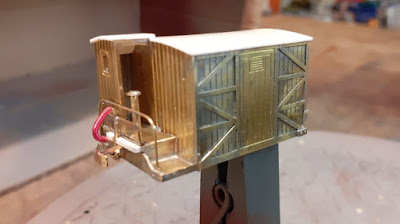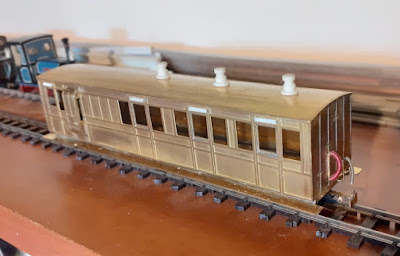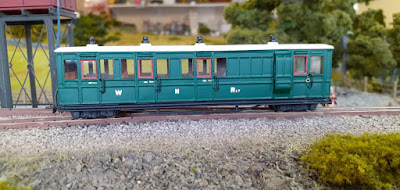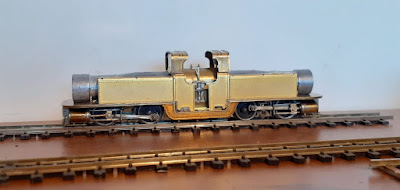Pages
Friday, 31 December 2021
Review Of The Year - Part 4
Wednesday, 29 December 2021
Review Of The Year - Part 3
In order to better represent the Dinas shunter, number 9, I produced a styrene master for some alternative bonnet doors and grills which I turned into a casting.
Monday, 27 December 2021
Review Of The Year - Part 2
June
The paint job on the Pickering brake was one of the more straightforward ones so we didn't have long to wait for a picture of it posed ready for service on Bron Hebog.
Saturday, 25 December 2021
Thursday, 23 December 2021
The Final Track Pin
I have completed the track laying on the narrow gauge side of the 'test track' layout.
The final section was a couple of sidings into the shed area, for which I had to raid Himself's stash of joiners for the handful I was missing.
It's strange to think that it's exactly a year since my son received his first proper 'train set' for Christmas and now I have a permanent layout in my home for the first time in more than thirty years.
Its *ahem* just for testing, of course, but I've found there are a surprising number things that require testing on a regular basis, and it's a burden I am willing to bear....
The locomotive in the pictures is the only one I have to hand to pose a couple of shots that emphasis the diminutive size of the smallest 009 locos, even though they are to the same scale as the standard gauge ones.
It was purchases a few months ago to use as a donor for its Minitrains F&C outside frame chassis.
I have a idea for a couple of locomotives for the 'test track' using the aforementioned chassis and a 3D printed body designed in the Alps - I will tease you with that and you can try and guess what I have in mind.
Tuesday, 21 December 2021
Review Of The Year - Part 1
February
This was the year my son reached an age where he was ready for his first OO layout, and I found my moulding and resin casting skills came in handy fixing a second hand Mainline wagon which had lost one of its sliding doors on one side.
March
Our James Spooner II project was in danger of running perilously far ahead of the real build as Himself had a play around with the etches to see how the half cab arrangement would work,
Sunday, 19 December 2021
Big Meets Small
Tracklaying on the narrow gauge side of the 'test track' has continued apace this weekend, and already I'm getting a glimpse of the 'Blaenau Central' effect I was after.
I 've read many articles about the very creative track plans people have come up with for small spaces, but this is unashamedly a traditional oval, planned to function as a 'train set' for my youngest, partially justified by having somewhere to test the running of my NG models, which until now have always had to be dispatched to Himself for proving runs.
So on the NG side we're going to have a simple island platform with a long turnback / storage siding (at the bottom end of the picture) and at the other end a point leading off into a separate shed area alongside the standard gauge steam MPD.
At the top right, just after the track swings past the goods yard weigh house, there is another point into a short transfer siding where the standard gauge coal wagons can discharge their load into NG wagons waiting below.
My first experience laying 009 track has been fun.
The fishplate joiners for the smaller code rail are much more fiddly to handle that the Code 100 stuff - and even I've had to squint a little at times - but I found I soon got used to it, and some test passes with the half-built Worsley bowsider on Dundas FR bogies suggests all is well so far.
Thursday, 16 December 2021
Diversionary Tactics
Something that was proven during the early stages of the Covid pandemic is what marvellous therapy making model railways is to take your mind off all the worry about what might, or might not, be coming down the tracks towards us.
Perhaps its no coincidence, given the current situation with the Omicron variant, that I have decided to start some serious planning, and track laying, on the narrow gauge part of the 'test track'.
I'd held off on this until we'd made some solid progress with the electrics on the standard gauge layout.
Now that around half the point motors are fitted and wired up it seems like the right time to decide on where the two foot tracks will go.
I'm really keen to emphasise the different in size between standard and narrow gauge, which is very apparent when they're in close proximity, just like the effect you get at the headshunt at Blaenau Ffestiniog station
Thursday, 9 December 2021
Stuffed And Mounted
A rite of passage for anyone of my generation - by which I mean growing up in the 70s and 80s - was attempting the Blue Peter 'makes', where kids were encouraged to recycling household objects into something useful, or as a means of faking the unobtainable / unaffordable.
They ranged from the infamous fake Thunderbirds 'Tracey Island' to the annual Advent Crown, which in hindsight must have prepared an entire population for a life of potential pyromania.
These projects were never entirely successful in my experience.
I recall when I sat and watched one of the presenters transform a used fabric softener bottle into a convincing statue of a Golden Retriever puppy.
Then I attempted it with my Mum.
It didn't look anything like the one on the telly.....
So you'll perhaps understand why, when flicking the latest edition of Model Rail magazine, I didn't linger long at an article enticing the reader to create a diorama in a jam jar.
'Been there before....', I thought to myself.
However, I reckoned without the persuasive powers of a young boy, who brandished the same magazine under the nose of Himself and suggested - in the way only 8-year-olds can suggest things to gullible grandparents - that it would make a great wee project for him.
As if he hasn't got enough to be getting on with...
Literally within hours, when I arrived to collect the young persuader, Himself was already well on the way to fulfilling the challenge, with a wooden stand made and some redundant models selected to be sealed away in the glass chamber.
I can't remember where or when we got the loco, or what it's origins are, but it was never part of our running fleet.
Its last useful function was as a test bed for glue 'n' glaze cab spectacles, and Himself has now removed the motor for the purposes of display.
The slate waggons were apparently from our original fleet of Dundas kits, which now have very ropey axle boxes after many laps of Dduallt.
I have to admit it's a very effective little scene, and clearly a viable project with good step-by-step instructions in the mag.
From this we can learn two things.
1) I shoudn't be so cynical about these projects next time.
2) I made a tactical error 40 years ago not getting Himself to watch Blue Peter with me.....
Tuesday, 7 December 2021
Spare Pickering
Sunday, 5 December 2021
1870 And All That
The arrival of a radical new locomotive in the top left hand corner of Wales always brings the irresistable urge to put it to the test and see what it's capable of.
In 1870 it was the FR's pioneer Double Fairlie Little Wonder and in 2021 it's the Bachmann 009 version which I suspect will be as much of a game-changer for the scale as the real locomotives were for the FR and for narrow gauge railways in general.
This time we didn't bring along Russian Imperial observers - just me with my iphone - but the principle was the same: find a hill and hang the longest train you can on the back and see what it can do.150 years ago the newcomer Little Wonder was up against the incumbant in the form of Large England Welsh Pony.
For our version we pitted the DCC sound fitted Earl of Merioneth against the eldest of our fleet of Backwoods Miniatures Fairlies, Merddin Emrys.
The results were obvious enough if you watch the video, so I won't explain it all here, but a little bit of background context will be helpful.
The Bachmann model has been pulled apart and some extra weight added in the empty space in the tanks, but unfortunately I forgot to bring along my digital scales for the test so I can't tell you how much was added, or how the RTR model compares to the Backwoods which is 100% brass construction.
What I can say is that despite the alterations it wasn't able to haul much more than the Bachmann model of Livingston Thompson which has not been touched - and will probably be left alone as a result of these tests.
So are we disappointed? Not really.
It would have been nice if it could have handled a rake of six, but I'm not sure that the real locomotive - which by the end of its working life was beginning to struggle by all accounts - could take many more than four of the current FR super saloon carriages up the 1:40 grade.
The capablity of the Backwoods models on our layout far exceeds the prototype, indeed, our Merddin was limited only by the output of the motor in this test, requiring full power and feeling distinctly warm to the touch afterwards.
It's more than 25 years old now, and such is the design of the Backwoods kit it's impossible to get the motor out to replace it, so we need to take care of the old girl.
What's more, nether of the models we have bought should ever run on either Bron Hebog or Dduallt if we're being prototypical, so they're strictly for Rule 1 specials.
The green Earl looked very nice on a set of 4 carriages in red livery, and I suspect once we've given the carriage bogies an overhaul it could handle 5 quite comfortably, and LT will look good on a vintage freight or a short Victorian set running a short service from Port to Beddgelert.What is sure is that as gorgeous as the Bachman models look, the Backwoods Fairlies aren't going to be retired from mainline duties on our layouts any time soon!













































